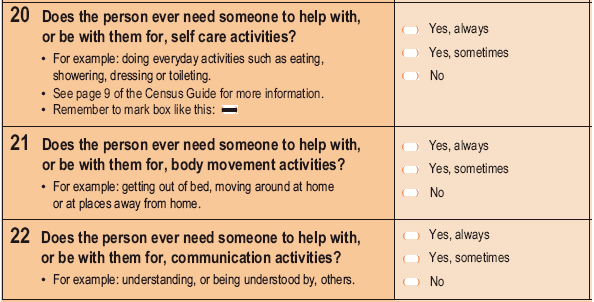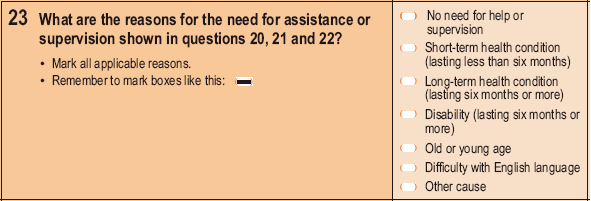NEED FOR ASSISTANCE
JUSTIFICATION
Data on people who need assistance due to a severe or profound disability are required for developing federal and state government policies and community-based programs, and for program and service delivery funding allocation.
Detailed data at the small area level and for small population groups are particularly useful for this topic.
HISTORICAL INFORMATION
Questions relating to disabilities of respondents were included in the 1911, 1921 and 1933 Censuses. Respondents were asked to indicate whether they were deaf, dumb or blind. A more general question on the effect of disabilities was asked in 1976. However, the quality of data obtained from this question was poor and no results were released.
The ABS established a Census Consultative Group on Disability in 1995 to seek user input and to identify user requirements for this data, research international practices and develop and test disability questions which might provide acceptable and accurate data. Disability questions were not included in the 1996 and 2001 Censuses as the questions developed proved unsuitable for a self-enumerated form.
An Advisory Group on Disability was again established in 2003 to develop a suitable question for the 2006 Census and review the concepts these questions were attempting to measure. The Advisory Group agreed that for the 2006 Census the questions on disability should be based around the concept of 'profound or severe core activity limitation' using similar criteria to the ABS Survey of Disability, Ageing and Carers. Testing of the new questions indicated that the data would be of an acceptable quality for use as an indicator of the target population.
COMMENTS
This topic identifies people who report a need of assistance due to a 'profound or severe core activity limitation', and is based on similar criteria to the ABS Survey of Disability, Ageing and Carers. This population is defined as people with a disability who need assistance in their day to day lives with any or all of the following core activities - self care, body movement or communication - due to a disability, long-term health condition or old age.
While this topic is based on the criteria used in the ABS Survey of Disability, Ageing and Carers, the population measured is different as a result of the collapsed question format and different collection methodology. On this basis, data for this topic should be taken as an indication of the characteristics of people who report a need for assistance due to a disability, long-term health condition or old age, not as the total population prevalence of people with a 'profound or severe core activity limitation' as represented in the survey data.
USER REQUIREMENTS
Data on disability are required for:
- the development and monitoring of federal and state government policies and community-based programs
- program and service delivery funding allocation for small population groups and small geographic areas.
AVAILABILITY OF NON-CENSUS DATA
Survey data about disability are available from:
However, these surveys do not provide reliable data at the small area level or for small population groups.
Non-ABS Data are available from Centrelink and the Department of Family and Community Services and Indigenous Affairs (FaCSIA) in relation to recipients of relevant pensions and benefits. However, this data is not a good indicator of the prevalence of disability in the population as not all people with disabilities receive a pension or benefit. Data on recipients of disability services are available from the Australian Institute of Health and Welfare (AIHW).
POSSIBLE CHANGES FOR 2011
As this topic was asked for the first time in the 2006 Census and the data has not yet been evaluated, there may be some changes made to the questions for the next Census.
2006 CENSUS QUESTIONS


 Print Page
Print Page
 Print All
Print All
 Print Page
Print Page
 Print All
Print All